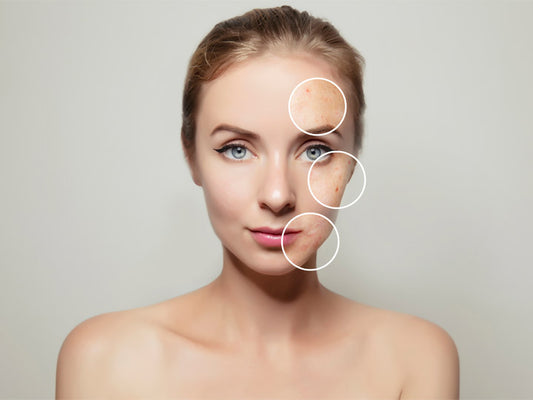Does your confidence go for a toss at the sight of a blemish? You are not alone. Many women experience low confidence due to these imperfections on the skin. However, there are a lot of treatments available to manage blemishes. But before that, you need to be aware of your skin.
A blemish is any type of spots, discoloration, mark or flaw on the skin.
Types Of Blemishes
- Acne
- Rash
- Age spots
- Birthmarks
- Melasma
1. Acne

Acne (acne vulgaris) is caused when oil, bacteria and dirt block a hair follicle on your skin.
A. Causes
- Hormones
- Stress
- Certain medications
- Poor hygiene
- Wrong skin care products
- Sun
- Unhealthy Diet
B. Treatment
Blemishes or dark spots caused by acne can be cured with pigment reducing actives available in the form of creams and serums.
2. Rash

Skin rash is characterized by a change in the skin color and texture. Following are the causes [3] for skin rash.
A. Causes
- Hot and humid weather
- Excess sun exposure
- Food allergies
- Dry skin
- Insect bites
- Medication effects
- Fungal or bacterial skin infection
B. Treatment
Paracetamol or ibuprofen (advil) relieve the mild pain associated with rash. Do not use harsh and scented skincare products. Blemishes caused by a rash can be treated with pigment reducing actives.
3. Age Spots

Age spots, also called liver spots, commonly occur in people over the age of 40.
A. Causes
Exposure to sun leads to overactive skin pigment cells. This accelerates the production of melanin in certain areas of the skin, leaving harmless age spots.
B. Treatment
Bleaching agents containing hydroquinone can be used[1].
4. Birth Marks

Birthmarks are abnormalities of the skin that are present when a baby is born. There are two types of birthmarks:
- Vascular birthmarks are made up of blood vessels that haven't formed correctly.
- Pigmented birthmarks are made of a cluster of pigment cells which cause color in skin.
They can be many different colors, from tan to brown, gray to black, or even blue. Moles can be birthmarks. [2]
A. Causes
The cause of birthmarks is unknown.
B. Treatment
Most birthmarks are harmless. Vascular birthmarks can be removed using laser surgery[3].
5. Melasma

Melasma is caused due to excess production of melanin (skin pigment). [4] It is characterized by dark patches on the skin.
A. Causes
- Exposure to sun
- Hormonal abnormalities
- Birth control pills
- Pregnancy
B. Treatment
Topical treatments for melasma include iron oxide, hydroquinone, azelaic acid, kojic acid, corticosteroids, etc. Oral treatments include tranexamic acid, polypodium, leucotomos and glutathione. Procedural treatments include laser, chemical peels and microneedling. [5]
What Is The Difference Between Acne And Blemishes?
Acne is a skin concern characterized by pimples, blackheads and whiteheads. Blemish is a condition where the skin is decolorized. Acne and blemishes are not to be confused for the same kind of skin condition. But blemish can form as a result of acne.
When Should You See Your Doctor?
Make a visit to your doctor if your blemish
- Changes in size or color
- Begins to bleed
Are There Any Home Remedies For Blemishes?
People have been using a lot of home remedies to clear blemishes on face based on ancient science. Although these are not scientifically proven, they have yielded effective results.
1. Tomato Juice
Tomatoes are rich in Vitamin C and antioxidants. Their astringent properties clear blemishes.
2. Aloe Vera
Aloe Vera not only heals blemishes but also helps in the growth of new skin cells.
3. Egg White
Egg white contains natural enzymes that help in lightening the skin.
4. Honey
Honey has anti-inflammatory properties and antioxidants that lighten the scars.
5. Lemon Juice
Lemon juice is a natural bleaching agent that lightens scars and blemishes. Other natural ingredients that have the potential to fade away blemishes are cocoa butter, baking soda, apple cider vinegar, potato juice, neem, papaya, oatmeal mask, shea butter, yogurt mask and turmeric mask.
What Are The 5 Vital Steps to Avoid Blemishes?
1. Eat healthily
2. Get adequate sleep
3. Lead a stress-free life
5. Exercise to flush out toxins
What Is An Ideal Skincare Routine?
Following a skincare routine religiously not only keeps the blemishes away but also leads to healthy skin. No matter how many steps you want to incorporate in your skincare routine, make sure you don’t forget these basics.
A. Cleansing
Cleansing is the first and foremost step in any skincare routine. It helps get rid of dust, dirt, excess oils and makeup residue from your skin. Cleansing prepares your skin for the application of next set of skincare.
An ideal cleanser should be gentle and deep cleansing rather than over cleansing. Cleansing should make your face look clean without stripping off the natural oils and disrupting the pH balance of the skin.
B. Toning
Cleansing often disrupts the pH balance of your skin. A toner will bring it back to normal.
C. Moisturizing
Moisturizing is an important step if you aim to keep your skin healthy. Irrespective of the skin type, moisturizing is important. It offers hydration to the skin and also repairs the skin’s natural barrier.
Apply a broad spectrum sunscreen post moisturizing to protect your skin from the harsh sun rays.
D. Treating
If you are struggling with skin concerns like acne, tan, dark spots or premature aging, use a serum to address them. A serum should be applied soon after cleansing to reap the maximum benefits.
E. Exfoliating
Exfoliating means getting rid of dead skin cells. Exfoliate your skin once a week to wash away dead skin cells.
Before you begin a skincare routine for your skin, it is crucial to know about your skin and it's unique needs. Take SkinKraft’s SkinID™ questionnaire to get a FREE Skin Analysis and a customized skincare recommendation.
Recommended Products
Was this Article helpful?
- Least helpful
- Most helpful











